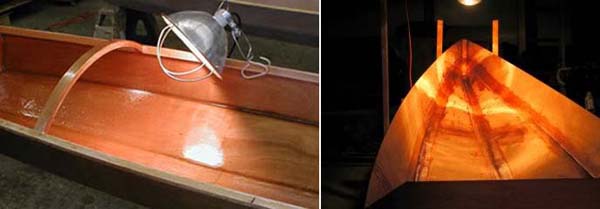Epoxy Help
PROPER MIXING OF EPOXY RESINS
During colder seasons, the epoxy resin and curing agent will be thicker or higher in viscosity. Temper both components to at least 70°F to 80°F
Before mixing to obtain the best result and improve ease of use.
A good method is to place the bottles in a warm room for 24 hours or place both components in a plastic bag and seal tightly and then place in hot water bath for about 2 to 4 hours. Remove from the water bath and insure that the components are below 80°F before mixing together.
This will lower the viscosity to the consistency as shown on this video demonstration.
Please view the following video for the proper mixing of epoxy resin. It demonstrates the proper technique of mixing any type of epoxy resin regardless of mix ratio or formulation. Evidence of proper mix technique click on the picture to pause or play slide show.
The slide show demonstrates one of the most common causes of tacky and uncured spots problems, which can be directly correlated to the quality and mix technique.
Proper mixing technique
The following mixing demonstration can be applied to any multi-component polymer systems the final cure and performance of any epoxy resin system is highly
dependent on the quality and thoroughness of the mixture and blending of the plural or two component resin system.
The resin and curing agent must be mixed to homogenous consistency.
The thoroughness and the mix quality of the prepared resin system is evident in this mixing demonstration.
The resin and curing agent must be mixed together with absolute thoroughness to a homogenous consistency to achieve proper cure and tack free results. Although MAX CLR was used in this presentation, it demonstrates the proper technique of mixing any type of epoxy resin.
The proper cure and final performance of any epoxy resin system is highly dependent on the quality and thoroughness of the mix.
The resin and curing agent must be mixed to homogenous consistency to obtain the formulated performance of the epoxy resin.
Mixing higher viscosity (thicker) resin systems
To determine coverage of a flat, smooth none absorbent surface, determine the length x width x thickness in inches to obtain the cubic volume in inches.
Use the following equation: 1 gallon of resin can cover 1608 square feet per 1 mil or 0.001 inch cured coating thickness. (length x width x coating thickness)/ 231 cubic inches per gallon = Total number of gallons of resin needed
For example:
So by obtaining the volume and knowing the specific density or weight per unit
volume one can calculate the theoretical amount of resin needed.
For example:
50 inches x 36 inches x 0.010(10 Mils desired coating thickness)
18 cubic inches / 231 cubic inches per gallon = .0779 gallon of mixed resin needed
or
231 Cubic inches per gallon x .0779 gallons 18 cubic inches of mixed resin needed
or
4195 grams x .0779 = 326.79 grams
Use the following factors to determine the gallons needed and then convert it to the appropriate volume or weight:
FLUID GALLON VOLUMETRIC CONVERSION
| 1 gallon = 231 cubic inches |
| 1 gallon = 128 ounces |
| 1 gallon = 3.7854 liters |
| 1 gallon = 4 quarts |
| 1 gallon = 16 cups |
For useful physical and conversion data and geometry formula visit www.onlinecoversion.com for an extensive
collection of conversion and formula
ELEVATED TEMPERATURE CURING TECHNIQUES
A heat post cure method using infrared lamps (120°F to 150°F for 2 hours) after it has cured to a none tacky-dry to the touch state will insure a full cured polymer. Use an infrared heat lamp for larger parts if a process oven is not available.  During the chemical reaction, the mixture will release exothermic energy, which manifests as heat energy. Depending on mixed volume or amount of resin mixed, the heat energy that is produced can cause a "run-away exothermic reaction" and can reach temperatures in excess of 300ºf and cause severe burns, hazardous chemical fire and noxious fumes. If this occurs, here are some basic safety procedures to prevent personal injury and property damage. During the chemical reaction, the mixture will release exothermic energy, which manifests as heat energy. Depending on mixed volume or amount of resin mixed, the heat energy that is produced can cause a "run-away exothermic reaction" and can reach temperatures in excess of 300ºf and cause severe burns, hazardous chemical fire and noxious fumes. If this occurs, here are some basic safety procedures to prevent personal injury and property damage. The reaction cannot be stopped but it can be minimized by immersing it in a container of cold
water to prevent auto-ignition and reduce the outgassing of noxious fumes.
One of the major cause of "run-away reaction" is the mass of the epoxy mixture as well as the reactivity or working time of the resin system.
When mixed in a large mass and if allowed to react in a concentrated volume, the initial heat it produces causes a cyclic or domino-effect,
Accelerating the chemical"run away" reaction via temperature induction.
For example, a 4-ounce volume of mixed resin spread over a 5 square foot area can remain as a liquid for hours while the same volume of mixed resin confined in a cup can cure as fast as 90 seconds, depending on the formulation. The video demonstration above was less than 4-ounces of resin,
The larger the volume, the higher and faster the exothermic heat release.
Understand this discipline and always practice safety first.
PLEASE CALL US TOLL FREE
877-403-8008
Monday to Friday
9:00 am to 4:30 pm
polymercomposites@msn.com
More Tech info
Web site and all contents © Copyright Polymer Composites Inc,, All rights reserved.
|